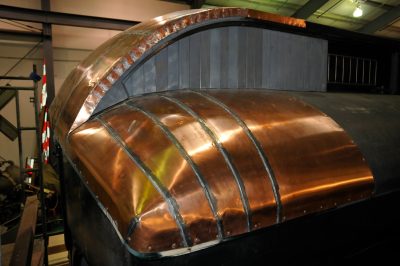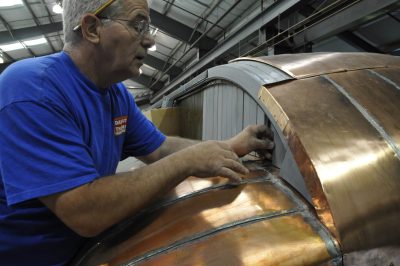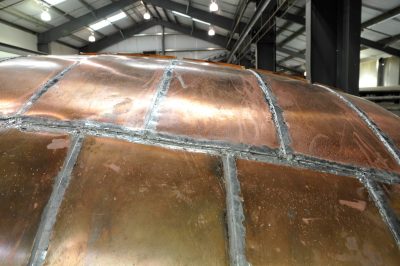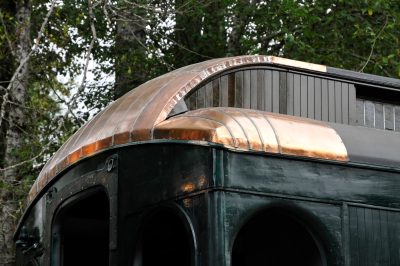Most early 20th Century railroad coaches had canvas roofs. Some railroads specified that the entire roof be clad with canvas while others preferred copper cladding on the car ends. Copper was not an afterthought, but an option specified when the cars were built. Oxidation and the limitation of black and white photography often make it difficult to identify this in the 1912-era photos, but the Museum is confident that coach 218 was built with copper hoods.

Completed lower hood. One improvement over 1912 materials is the use of marine calking to seal edges.
Certainly, one of coach 218’s distinguishing features is this copper cladding on the roof ends, but unfortunately the original surviving copper was brittle and riddled with perforations. So restoring these to their “as built” appearance and condition has been one of the project priorities. These “hoods” feature compound curves and are areas where it is more difficult to keep out rainwater on this design of railroad car. The copper cladding improves durability and reduces long term maintenance. (Some years ago, Spike had an opportunity to work on two Canadian Pacific Railway passenger cars that featured full canvas roofs and can attest to the fact that the canvas fails first on the compound curve at the ends of the cars.)

Bob M. attached the last of the clerestory cladding to allow the final piece of copper to be attached.
The design of the hoods is simple but the tin smith skills to install it are no longer common. Fortunately, Gary J. is a highly accomplished marine carpenter, and this work was an easy adaptation for him. To begin, copper sheets were cut into small rectangular sections that would conform to the roof curve. The edges were bent up or over to allow a folded seam with the adjacent roof panels. All the seams were tapped flat and then soldered to provide a watertight seal. The final product mimics the original roof, but the appearance of the soldered seam is slightly different, probably because of the difference in performance between an internally and externally heated soldering iron.
Work continues on coach 218 but completion of the copper hoods allowed its use during Railroad Days 2013 where it carried an estimated 120 additional passengers. Work is being funded with the generous support of 4Culture, the Nysether Family Foundation, proceeds from GiveBIG 2013, the Snoqualmie Tribe, and individual contributions from people just like you!



